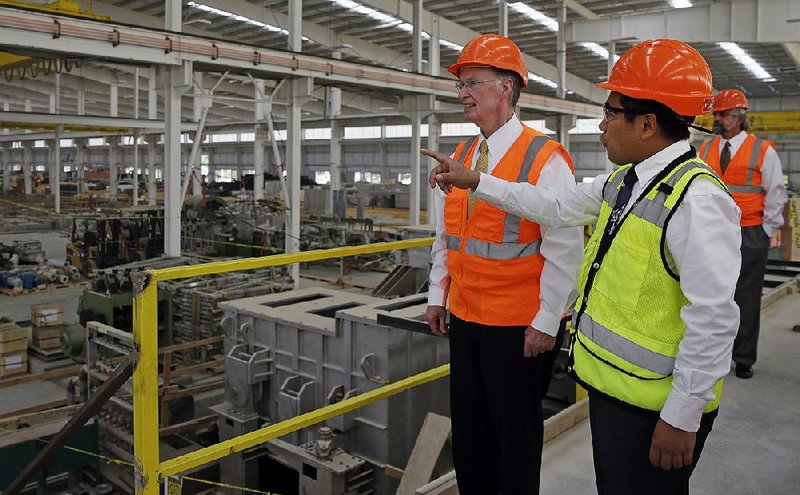PINE HILL, Ala. -- Burdened with Alabama's high unemployment rate and long abandoned by textile mills and furniture plants, Wilcox County desperately needs jobs.
They're coming from a most unlikely place: Henan Province, China, 7,600 miles away.
Henan's Golden Dragon Precise Copper Tube Group opened a plant in Pine Hill last month. It will employ more than 300 in a county known less for job opportunities than for lakes filled with bass, pine forests rich with wild turkey and boar, and muddy roads best negotiated in four-wheel-drive trucks.
"Jobs that pay $15 an hour are few and far between," said Dottie Gaston, an official in nearby Thomasville.
What's happening in Pine Hill is starting to happen across America.
After decades of siphoning jobs from the United States, China is creating some. Chinese companies invested a record $14 billion in the United States last year, according to the Rhodium Group research firm. Collectively, they employ more than 70,000 Americans, after creating few jobs a decade ago.
Powerful forces -- narrowing wage gaps, tumbling U.S. energy prices, the vagaries of currency markets -- are pulling Chinese companies across the Pacific. Mayors and economic development officials have lined up to welcome Chinese investors. Southern states, touting low labor and land costs, have been especially aggressive.
In the case of the Pine Hill plant, tax breaks, Southern hospitality and a tray of homemade banana pudding helped, too.
"Get off the plane, and the mayor is waiting for you," Hong Kong billionaire Ronnie Chan said.
In March, Dothan, Ala., held a two-day U.S.-China manufacturing symposium, drawing dozens of potential Chinese investors. On sale were T-shirts reading: "Ni hao, y'all" -- combining the Chinese version of "hello" with a colloquial Southernism.
Chinese executives wandered around during a street festival, experiencing Americana by snapping photos of vintage '60s muscle cars. A Chinese company, in a deal negotiated before the symposium, announced it would take a 3-D printing operation to Dothan.
Among other Chinese projects in the United States that are creating jobs:
• In Moraine, Ohio, Chinese glassmaker Fuyao Glass Industry Group Co. is taking over a plant that General Motors abandoned in 2008 and creating at least 800 jobs. The site puts Fuyao within four hours' drive of auto plants in Ohio, Kentucky and Indiana.
• In Lancaster County, S.C., Chinese textile manufacturer Keer Group is investing $218 million in a plant to make industrial yarn and will employ 500. South Carolina nudged the deal along with a $4 million grant.
• In Gregory, Texas, Tianjin Pipe is investing more than $1 billion in a factory that makes pipes for oil and gas drillers. The company expects to begin production late this year or early in 2015. It is expected to have 50-70 employees by the end of this year and 400-500 by the end of 2017.
The United States and China have long maintained a lopsided relationship: China makes things; America buys them. The U.S. trade deficit in goods with China last year hit a record $318 billion. And for three decades, numerous U.S. manufacturers have moved operations to China.
The flow is at least starting to move the other way. One reason is that in the past decade, the cost of labor, adjusted for productivity gains, has surged 187 percent at Chinese factories, compared with just 27 percent in the United States, according to Boston Consulting Group.
In addition, Chinese electricity costs rose 66 percent, more than twice the United States' increase. The start of large-scale U.S. shale gas production has helped contain U.S. electricity costs.
And the value of China's currency has risen more than 30 percent against the U.S. dollar over the past decade. The higher yuan has raised the cost of Chinese goods sold abroad and, conversely, made U.S. goods more affordable in China.
Those rising costs have cut China's competitive edge. In 2004, manufacturing cost 14 percent less in China than in the United States; that advantage has narrowed to 5 percent. If the trend toward higher wages, energy costs and a higher currency continues, Boston Consulting predicts that U.S. manufacturing will be less expensive than China's by 2018.
Cost isn't the only allure. As Chinese companies build more sophisticated products, they want to work more directly with U.S. customers.
"Being close to the marketplace is good for everybody," said Loretta Lee, a Hong Kong entrepreneur who just opened a shoe factory in Tennessee.
Business on 06/24/2014
